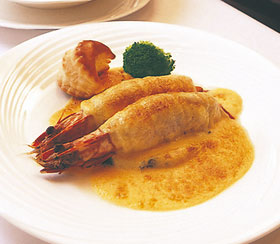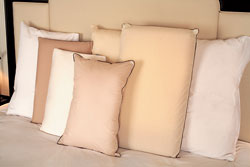Special Feature![]() Welcome to the Land of Hospitality
Welcome to the Land of Hospitality
New ideas picked up worldwide
The Imperial has brought some revolutionary ideas to the hotel industry in Japan and other countries, ideas no other hotel would think of. Perhaps the most significant is the complete wedding package. Japan has many venues for wedding receptions, but the Imperial developed a Japanese-style, in-house package — the first of its kind — that includes a special hall for the formal ceremony, dressing rooms, makeup and hairstyling services, a large room for the reception, and a photo studio for the wedding pictures.
Wedding customs are seen as part of a country's traditions, but many of those customs developed at some moment in the past into a popular trend. For example, the white wedding dress was inspired by the one worn by Queen Victoria of Great Britain. The Japanese custom of marrying at a Shinto shrine before the god enshrined there is said to have become common, in a simplified version, after the Shinto wedding of Emperor Taisho (1879-1926) at the Imperial Palace. The Imperial Hotel quickly latched onto this trend and set up a shrine-like altar inside its premises for Shinto weddings, to be followed by the reception. The problem, though, was that some Shinto priests did not like the idea of going to a Western-style hotel to perform the ceremony. But then the Great Kanto Earthquake of 1923 left many of Tokyo's shrines in ruins or burned to the ground, while hardly touching the Imperial Hotel designed by Frank Lloyd Wright. As a result, the number of Shinto-style weddings quickly jumped at the Imperial, and the hotel soon constructed its own permanent shrine on the premises, becoming the first in Japan (and the world!) to offer both a wedding ceremony and a reception, with all the trimmings, in a hotel.
It certainly seems strange to walk through a Western-style hotel and suddenly glimpse, through an open door, a gorgeously decorated Shinto shrine. This is one unique feature of major hotels in Japan. (Here I should mention that Christian-style weddings are now growing in popularity in Japan, while Shinto weddings are on the decline — although this custom does not really imply that the population is embracing Christianity.)
The Imperial Hotel created another trend when it introduced the service charge. Hotels and luxury restaurants in Japan now add a 10% service charge to the bill, with the understanding that there is no need to tip the staff. This system is now used in Europe and elsewhere. Before, staff directly serving guests would receive far larger tips than other service workers, creating unfair income disparities. The service charge solves this problem and eliminates worries about how much and when to tip. This may explain why this system has spread worldwide.

The Imperial was the first to offer a "Hotel Wedding Package," which includes ornate preparations for the reception (1) and an imposing shrine for Shinto weddings (3). The tea room (2) is much appreciated as a quiet haven by both Japanese and foreign visitors.
A home away from home
At the heart of the hospitality offered at a Japanese hotel lies the desire to make life more convenient. This is true also for Japanese manufacturers of cars, electronic gadgets and other consumer goods.
Walk into a first-class hotel room in Japan and you are sure to find kimono-like yukata for sleepwear, toothbrushes, toothpaste, slippers and a razor. Although the Imperial Hotel did not start this trend, it is now certainly a part of it. Hotels in other countries offer an array of personal care items, but few provide sleepwear or toothbrushes, although it may be that a growing number make slippers, toothbrushes and toothpaste available. I am sure they took the idea from Japanese hotels like the Imperial, which are quietly but surely leading the world toward more comfort and convenience away from home. ![]()

Yukata (informal kimono-like wear, left) and slippers (center) are laid out for guests to use. The bathroom is stocked with toothbrushes, a razor, shampoo, hair rinse, a hair brush and other toiletries. This is typical of most hotels in Japan.

